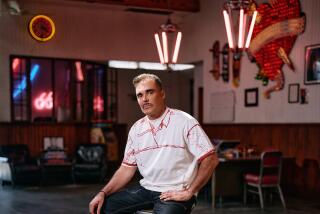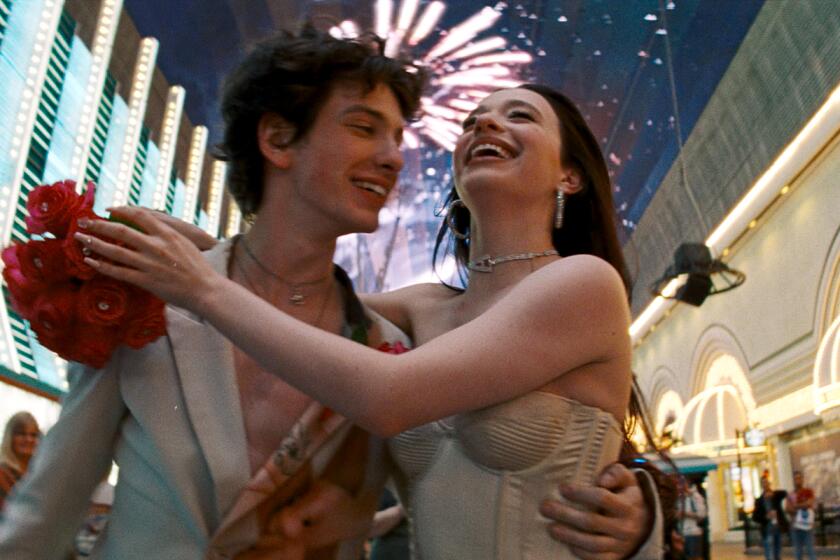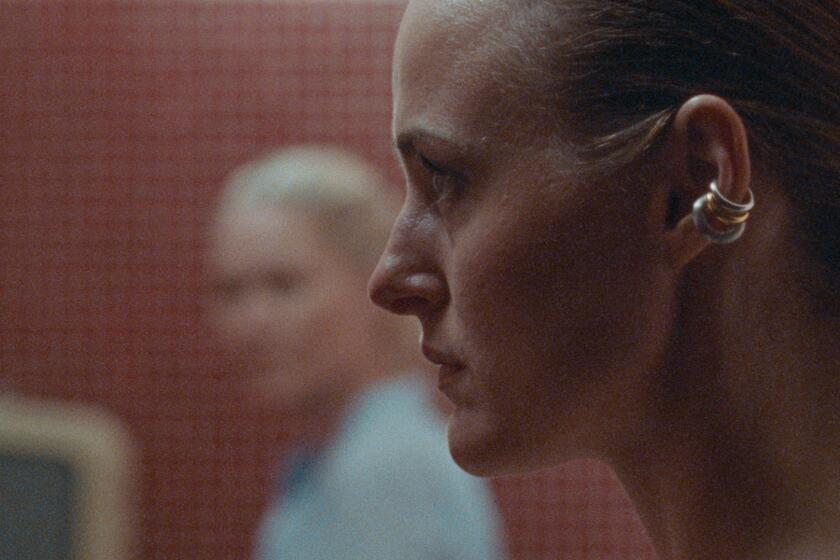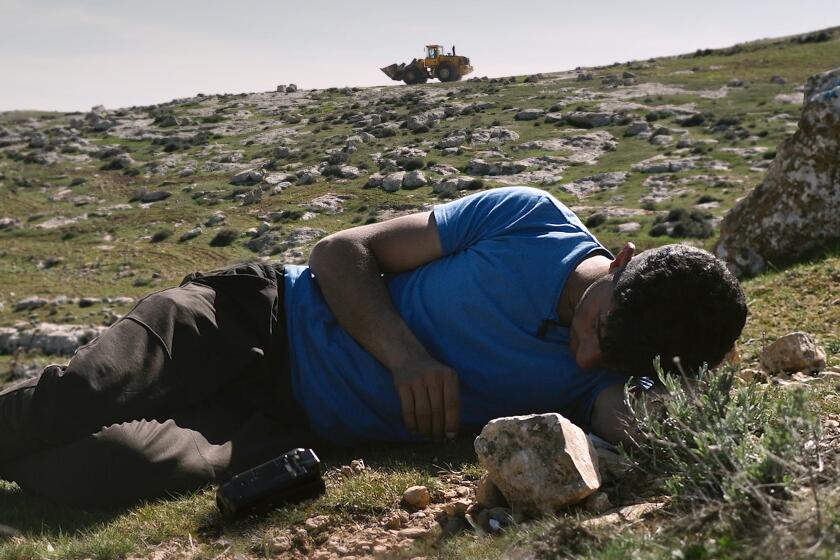Artist Uses Film to Paint Life Portrait : Art: Julian Schnabel, the ‘80s <i> enfant terrible </i> painter, is writing and directing the movie ‘Build a Fort, Set It on Fire,’ about his friend, the late artist Jean-Michel Basquiat.
- Share via
NEW YORK — The director is wearing Reeboks, untied, with no socks. His purple shirt is damp with sweat, his love beads are red and turquoise over an exceedingly hairy chest. Hard to say about the legs, since they’re covered in an orange sarong.
This is Julian Schnabel, the very rich and very famous enfant terrible painter of the ‘80s art world, as film director. Almost by default, he says, because he can do it best, he’s written and is directing a feature film, “Build a Fort, Set It on Fire,” about his friend, artist Jean-Michel Basquiat, who died of a heroin overdose in the summer of 1988, after a skyrocket rise from his Brooklyn roots to the apex of the Soho art world.
Schnabel, the artist, burst brazenly on the scene 15 years ago. His paintings sprouted smashed crockery, his posturing was out of Muhammad Ali. Schnabel very quickly came to seem the apotheosis of everything wrong with the art world: commodification, rampant careerism, upstart ambition, manipulation and hucksterism.
He was the artist people loved to hate and flocked so blithely to buy. He set himself up with a downtown loft and a Bridgehampton, N.Y., setting of fallen columns, swimming pools, picturesque wife and children, and himself as the tour guide, in tight black T-shirts, for maximum biceps display.
Now there’s a new wife and new children, and the East End scene has shifted to new digs in Montauk, where he plans to edit his film.
Schnabel, the film director, is a hard man to hate. Hucksterism and Hollywood may be a more palatable pairing than art and hype--or at least a handful of artists seem to think so. David Salle and Robert Longo have already released feature films this year. But with Schnabel it’s more than that. He’s gotten the moves right. The ego exhibits itself as a kind of charm now: the padrone at ease. Seen everything, likes it all. The biceps have turned to beef, the edge to amiability.
He’s heaving himself now out of the high director’s chair with the J.C.S. printed on back, shambling, in that caveman gait the untied Reeboks demand, to the camera, looking through the viewfinder. In an astonishingly professional manner.
“Jeff, could you just walk through the gate,” he calls across the street. And, “Do it again, Jeff.” Jeff is Jeffrey Wright, who won raves as the wise and flamboyant nurse in “Angels in America,” and plays Basquiat, in dreadlocks and old jeans.
And because they’re pals or admire one another, Schnabel was able to corral an impressive roster of cameo players who are working for scale and salary deferments: David Bowie as Andy Warhol, Dennis Hopper to impersonate the Swiss art dealer Bruno Bischofberger, Parker Posey as Mary Boone, Gary Oldman to play a thinner, suaver version of an artist who has a lot of things in common with Schnabel himself.
His involvement with the Basquiat film began five years ago when he was approached for information for a film a Polish director was doing. After a while Schnabel simply took over. He bought the rights to the film, and set out to write and direct it himself. “I didn’t want it to be a cliche--all collectors are stupid and artists are smart,” he says. “The truth is much more interesting than fiction.”
*
Schnabel’s version of the truth is an artist’s version. It tells a story of the 15-year-old boy, the son of a Haitian father and Puerto Rican mother, who ran away from home to create his own myth as the graffiti artist who rose to the pinnacle of the art world, became the protege of Andy Warhol and died young, leaving sufficient art and a large enough reputation for a major Whitney Museum retrospective four years after his death.
On this steaming summer’s day, Schnabel is shooting a scene that is supposed to take place in a sanitarium where Basquiat has come to visit his dying mother. The setting is the old brick Convent of the Sisters of Mercy, with a wrought iron gate that spells out the name. But this particular convent is located deep in the bowels of Brooklyn in a largely vagrant neighborhood that is on its way up from rock bottom.
Filming has had to go quickly. This is a low-budget film: $2.6 million, with a $600,000-contingency fund, all of it contributed by Schnabel and his friends, some raised by the sale of Schnabel’s own paintings.
“Starting filming was like jumping out of a car doing 30 m.p.h. in the middle of the Long Island Expressway,” he says. “There were 150 people in the first scene we shot--Dennis Hopper, David Bowie. So I had to land on my feet. I wrote a story, I’m telling a story, this is a movie about a part of my life. I was witness to something. If anything needs to be changed, I can rewrite it. I don’t have to have a meeting with 30 people.
“I’ve been reading all this junk in the newspapers about Jean Michel for so many years, I sort of thought if I told the story it would be more accurate and give him more his due. I don’t know gangsters and politicians, I know painters. I saw what happened to him.”
Schnabel has a microphone attached to his shirt, and a man with a camera is shooting everything Schnabel does. Jacqueline, Schnabel’s first wife, is collaborating with Olatz, his current wife, to make a film of Schnabel making a film. They live around the corner from one another, the three oldest children from the first marriage play with the two 22-month-olds from the second.
It is time to shoot the scene again. Wright by now has to be extracted from a gaggle of dread-locked young admirers in the crowd. Once more he walks through the sanitarium gates. “Action,” calls Schnabel. He puts on his glasses, hunches close to study the monitor.
Wright has a suggestion for Schnabel. Schnabel isn’t interested.
“Just thinking like a director,” Wright says.
“Just keep thinking,” Schnabel says.
Wright spent weeks with Schnabel in his studio learning to paint in preparation for the part. “It was almost like an apprenticeship, the best way to learn, I think,” Wright manages to say before Schnabel interrupts him. He’s genial about it, but this is Schnabel’s interview.
Schnabel leads the way into the convent courtyard. It’s an aberration in this neighborhood. New Orleans balconies, green calm, trees. “It looks like Pat O’Brien ought to be living here,” he says. Then he describes the shot in detail.
It comes naturally, he says. “I’m a painter. All my life I’ve been thinking about the rectangle.”
More to Read
Only good movies
Get the Indie Focus newsletter, Mark Olsen's weekly guide to the world of cinema.
You may occasionally receive promotional content from the Los Angeles Times.










